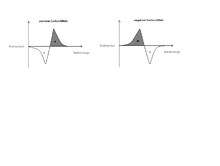Cotton effect
The Cotton effect (after the French physicist Aimé Cotton , who discovered it in 1895) is a phenomenon of optical activity . It is the characteristic change in the optical rotational dispersion (ORD) or circular dichroism (CD) in the vicinity of an absorption band of a substance.
In a wavelength region in which the light is absorbed , the absolute value of the optical rotation first varies rapidly with the wavelength, crosses zero at the absorption maxima and then varies again quickly with the wavelength, but in the opposite direction.
The cotton effect is called:
- positive if the optical rotation initially increases with decreasing (!) wavelength (as Cotton was the first to observe)
- negative , if the optical rotation first decreases with decreasing (!) wavelength .
Enantiomers have opposing Cotton effects.
Protein structures such as “ β-pleated sheet ” and “ α-helix ” show a negative Cotton effect with maxima at 199 and 205 nm, respectively. Disordered structures show a positive Cotton effect.
See also
Individual evidence
- ↑ A. Cotton: Absorption inégale des rayons circulaires droit et gauche dans certains corps actifs . In: Comptes Rendus hebdomadaires des Séances de l'Académie des Sciences Paris . tape 120 , 1895, pp. 989-991 .
- ^ A. Cotton: Dispersion rotatoire anomale des corps absorbants . In: Comptes Rendus hebdomadaires des Séances de l'Académie des Sciences Paris . tape 120 , 1895, pp. 1044-1046 .
- ^ A. Cotton: Recherches sur l´absorption et la dispersion de la lumière par les milieux doués du pouvoir rotatoire. In: Ann. Chim. Phys. tape 8 , 1896, pp. 347-432 .
- ↑ Ernest L. Elielm Samuel H. Wilen: Stereo Chemistry of Organic Compounds. Wiley, 1994, p. 1000.
- ↑ Wolfgang Bähr, Hans Theobald: Organic stereochemistry. Springer Verlag, 1973, ISBN 3-540-06339-0 , pp. 20-22.
- ↑ Belitz, Grosch, Schieberle: Textbook of food chemistry. Springer Verlag, 2001, ISBN 3-540-41096-1 , p. 58.
